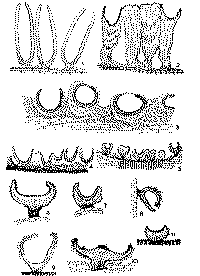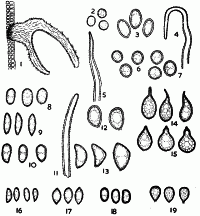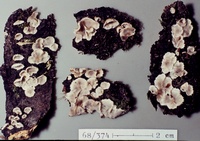|
 Lachnella pyriformis Lachnella pyriformis
SynonymsCyphella pyriformis
BiostatusPresent in region - Indigenous. Endemic
Images (click to enlarge)
Caption: FIG. 10: Section through pileus of Cyphella pyriforma. | 
Caption: FIG. 14: Spores of Cyphella pyriforma. | 
Caption: ZT68-374
Owner: E. Horak: © Creative Commons Attribution-Noncommercial 3.0 New Zealand |
Article: Cooke, W.B. (1961). The cyphellaceous fungi. A study in the Porotheleaceae. Beihefte zur Sydowia 4: 144 p.
Description: Receptacles scattered, membranous, brittle, 0,2-1,0 mm. in diameter, attached by a short
narrow base, at first subglobose, becoming pezizoid; exterior white, covered with a dense
tomentum of fine hairs curved over the hymenium, 5-6 µ in diameter, wall 1 µ thick, finely
crystal coated with occasional inflated areas at or near the apex; magin inturned, fimbriate;
hymenium surface concave, white becoming cream; context white, to 100 µ thick, to 250 µ at
the base of radiately arranged compact parallel hyphae, outer few layers tinted; generative
hyphae to 4 µ in diameter, wall 0,25 µ thick, branched, septate; hymenial layer to 60 µ deep,
paraphyses filiform, numerous, apically acuminate; basidia subclavate. 40-50x 10-12 µ 2-4-spored;
spores pyriform, flask-shaped or tear-shaped, base rounded, apex long-acuminate, 15-20 x 9-11 µ smooth, hyaline.
Habitat: Habitat: On Hebe salicifolia.
Notes: The above description was taken from Cunningham (1953). The writer would add that this is
an elaboration on the dochmiosporous type of spore with slightly larger spores than L.
alboviolascens, but with the same type of surface hairs and receptacles. Subhymenial clamps
are abundant in the portion of the type sent by Dr. Cunningham. This species is slightly
larger in all respects than L. turbinata.
Article: Cunningham, G.H. (1948). New Zealand Polyporaceae. 3. The genus Polyporus. New Zealand Department of Scientific and Industrial Research, Plant Diseases Division, Bulletin 74: 39 p.
Description: Pilei annual, scattered, membranous, brittle, 0.2-1 mm. diameter, attached by a brief narrow
base, at first subglobose becoming pezizoid; exterior white, covered with dense tomentum of
fine hairs curved over the hymenium, 5-6 µ diameter, wall 1 µ thick, finely crystal coated
with occasional inflated areas at or near the apex; margin inturned, fimbriate; hymenial
surface concave, white becoming cream. Context white, to 100 µ thick, to 250 µ at the base,
of radiately arranged compact parallel hyphae, outer few layers tinted; generative hyphae to 4
µ diameter, wall 0.25 µ thick, branched, septate. Hymenial layer to 60 µ deep, paraphyses
filiform, numerous, apically acuminate. Basidia subclavate, 40-50 x 10-12 µ, 2-4-spored.
Spores pyriform, flask-shaped, or tear-shaped, base rounded, apex long-acuminate, 15-20 x 9-11 µ, smooth, hyaline.
Habitat: HABITAT. Scattered on bark of dead twigs.
Distribution: DISTRIBUTION. New Zealand.
Notes: Pilei resemble those of C. villosa and C. alboviolascens; but the species differs appreciably in
the peculiar spores, which either resemble flasks with long necks or are tear-shaped with the
broad base attached to the sterigmata. Both C. pyriforma and C. turbinata possess filiform
paraphyses, whereas in the others described they are subclavate. In the sectional drawing
(Text-fig. C, fig. 10) tufts of hairs are shown growing from the hymenial surface, a condition
seen also in pilei of C. villosa and C. alboviolascens.
|